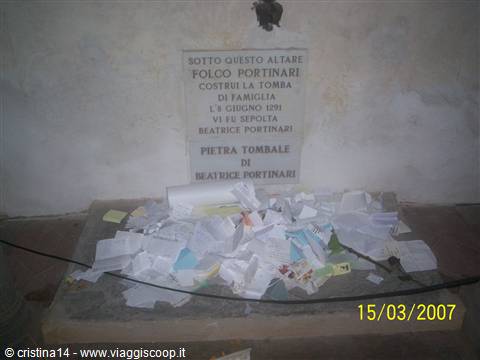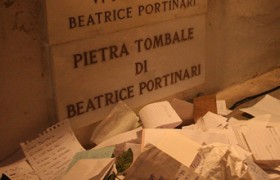Beatrice: An Unlikely Love Goddess 1# November 18, 2012
Author: Beach Combing | in : Medieval , trackbackDante’s Beatrice is one of the most famous and simultaneously obscure individuals in history. Dante lauded her to high heaven (literally) in his poetry on the basis of a couple of sightings: his love was steadfast, ideal and a little silly. But what do we know about the ‘true’ Beatrice? Well, most scholars believe that she was Beatrice Portinari (obit 1290), from a middle-ranking Florentine merchant family, though even that is not certain. If Beatrice was Beatrice Portinari then she married into the Bardi family, some unpleasant Florentine bankers, and died young, apparently without having children. Oh and another small detail: Beatrice has recently become a love goddess.
At the grave of Beatrice in Santa Margherita dei Cerchi Florentine girls have taken to leaving letters to their heroine and putting them on her headstone. It would be almost unspeakably caddish to go and read these letters: these are private matters, after all. But rumour says that they talk about unrequited love and that the correspondents ask Beatrice to intercede in matters of the heart. Some are perfumed, some have lipstick kisses, some are written on coloured paper, some look as if they are tear-stained…
The local priest has been surprisingly patient about this custom, which seems to have come into being in the last decade or so. There are even special baskets to place the letters in.
The modern world is a twisted and confusing place. But by what perversion of the intellect does the hero of a series of sexed-up medieval love poems get a temple built to her in a twenty-first-century Catholic church? Well, Beatrice’s qualifications seem to be the following.
First, actually desire doesn’t come much into Dante’s work. Beatrice is more one of Plato’s forms than the object, say, of John Donne’s lust. Dante even ends Il Paradiso by conflating poor Beatrice with the Madonna: there are worse fates but not many.
Second, Beatrice seems to have accidentally become not so much a love goddess as a love saint: and in terms of Catholic theology it is possible to ask for the dead – not just the holy dead though they are better at it – to talk to God on your behalf.
Third, Beatrice too suffered too from unrequited love. Well, actually she didn’t. That was Dante’s problem.. But perhaps the leaving of letters began with this misunderstanding: ‘Beatrice will ‘get me’ she went through the same thing.’
Now, of course, Bici (as she was called in the one document other than Dante’s poem that mentions her) must count Simone Bardi as her moment of salvation. He rescued her from an inflexible and humourless poet, who would have got bored and gone off in search of another ideal. Never fall in love with a poet…
But enough of kicking Dante. And consider this, though do not share this information with the heartbroken who go to leave their missives on Beatrice’s grave: scholars think that Beatrice was Beatrice Portinari because Boccaccio, who was often reliable about these things, says so. Note that he was writing a couple of generations after, well within living memory.
However, the evidence that Beatrice is buried in Santa Margherita dei Cerchi is extraordinarily slight. It boils down to this. Her father was buried there. Beatrice was surely (as Florentine custom required) buried with her husband Simone and the rest of the rapacious Bardis in not so nearby Santa Croce, where Florentines pretend that Dante is buried: actually he is Ravenna, (another post, another day). The headstone that the letters are placed upon is an opportunistic attempt by the church to lay claim to Beatrice’s bones. It reads: ‘Under this altar Folco Portinari built the family tomb and here was buried Beatrice, 8 June 1291’. Note that 1291 should probably be 1290 and the 8 June is a complete invention.
Other cases of invented love goddesses or invented love traditions: drbeachcombing AT yahoo DOT com Juliet is coming up…
20 Nov 2012: KR writes in ‘Beatrice the person was, for Dante, a saintly love, and in essence a virginal love, without evidence of lust. She represents the purity of admiration of a pre-pubescent boy in which the attributes of a virgin pre-sexual maiden are not tainted with physical lust. Remember, Dante was nine years old, Beatrice younger, when he “fell in love” with her. Beatrice represents the love for the eternal-virgin, and as such represents purity-before-lust in boykind and in Dante himself. In some respects, it represents the masculine wish to return to his own state of innocence and purity. In Eastern thought, in apocryphal books, we see Sophia as the goddess of wisdom, who is also seen as a generally unlustful goddess, who inspires a saintly love devoid of sexual overtones. In dichotomy of thought regarding females in Christian doctrines, a woman who is sexual is evil, whilst an asexual woman is good. Projecting their own sin of lust, men began to believe that a beauty who inspired lust was evil, whilst a beauty who did not inspire lust was good. Because beauty, as defined in the male perspective, most often leads to male lust, a beauty who inspired other-than-lust is rare and thus goddess-like in his perspective. Mothers, who were clearly sexual beings, caused some confusion in this mode of thinking and projecting. Without mothers, “holy” men would not be. Yet because mothers were most often the source of wisdom and love for boy children, they were beloveds-sans-lust from the standpoint of normal son-memory (Freud the fraud excepted) even though being lust objects from the standpoint of fathers. Thus Dante, a product of his era, names his first crush, Beatrice, as the prototypical female ideal of his era. She inspired admiration before he knew lust, and afterward, he kept her in his mind’s eye as representing the perpetual and holy virgin. After Beatrice’s death, Dante transforms virgin Beatrice to a Wise-Teacher-Holy-Mother figure and his teacher-guide in Purgatory. Beatrice-spirit, now envisioned as an archetypical Sophia-Mother Mary, scolds him for having lost his (holy) way since her death. That he names this “goddess” Beatrice (a name which has beatific and beauty both in it’s root) and associates her with his own pure (before sexual) respect-and-admiration-and awe (love) of the feminine certainly does not imply that the goddess represented by this name does not exist. Beatrice represented, for Dante, the essence of Minerva/Sophia and Virgin/Mother combined. Because man could not (and in many cases still cannot) conceive of holiness in beauty-woman, because he is subject to projecting his own lust upon her, only virgin maidens before they become sexual beings themselves, are to his hormone-warped understanding, pure. The only exception being the childhood concept of mother, before males were cognizant of their mother’s sexuality. In remembrances of childhood, then, man can conceive of woman as worthy, saintly, holy, teacher, guide, wise. But once he associates his own hormonal/penile lust/angst to the female, and becomes lustful himself, he projects. And woman, as a sexual being, falls from (male-concepts of) grace. In the mind of man, at least in Dante’s era, women who also desire sex, (unless under his personal tutelage) are whores. Girls who allow themselves to be persuaded into sex are sluts, whilst women who refuse to be persuaded are teasers and worse. In the minds of lustful males, women are to blame for male lust: he claims innocence. Dante cannot use his own wife as his muse, his model of holy-feminity, for he has had sex with her. Only the feminine as he knew it whilst HE was still pure-from-lust can then be pure. So, in essence, Beatrice the person represents for Dante all that he is capable of conceiving as holy and powerful in the female: Beatrice is Dante’s Mary-Sophia. Beatrice also represents Dante’s own real innocence: that innocent self which he remembers being in childhood, and which he knows is his soul’s salvation. “Beatrice” is only a Dante-made-up name, although based on an admired person, for a very real goddess-archetype. If Dante WAS able to comprehend this male-lust-projection dilemma, writing for a male audience of his day, he had no choice but to explain the feminine-as-worthy as a “Beatrice.” If he was NOT, he still had no other choice:Using “Minerva” or “Sophia” would have labelled him a pagan; Using “Mary” would have been blasphemy. The wonder is that any male of his era used a “holy-female” meme at all.’ Thanks KR!




